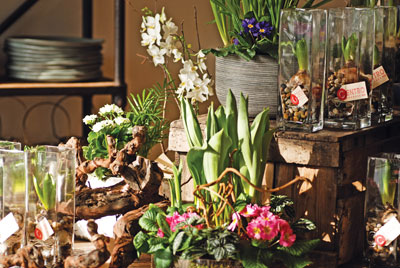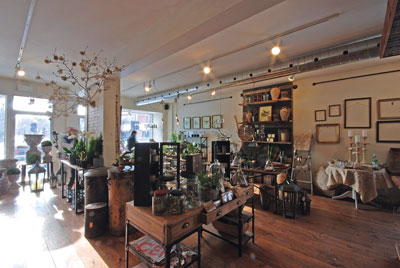
When it comes to botanical retailing, sectors have traditionally been separated much like church and state.
When it comes to botanical retailing, sectors have traditionally been separated much like church and state. The garden centres took care of the functional outside issues like flowerbeds, lawns and garden hoses. Florists on the other hand focused on the emotional side of the business – weddings, birthdays and courtship. Consumers, however, have begun mixing the two worlds together. When it comes to home sweet home, it appears as though people yearn to keep nature close to them at all times. While the physical walls may remain firmly in place, the psychological walls between outside and inside have come tumbling down. Natural materials abound inside while yards have become extensions of the house. It stands to reason that smart retailers will respond to this trend. Enter the urban garden centre.
 |
|
| Centro Garden features ready-made products to fit spaces of all sizes. (Photos by Barry Imber) Advertisement
|
Urban garden centres combine the best of plants, floral arrangements, home décor and often a little retailtainment to enhance the experience. These retail spaces often reside right beside fashion boutiques and restaurants and they boast both an indoor and outdoor space to showcase the product. While the melding of inside and outside spaces explains the scope creep for botanical retailing, it’s a deeper experience than simply grafting the two concepts together. These new retail spaces provide an opportunity for consumers to connect with staff and other customers in the store, with the product and with themselves.
Centro Garden in Burlington, Ont., is a perfect manifestation of these connections. While Centro Garden is the brainchild of local entrepreneur Jason Pepetone, Barry Imber of Insite Design (also in Burlington) worked with him to develop the brand positioning for the store. Imber feels that consumers make an emotional connection when they’re able to quickly visualize how a purchase might transform their own space.
“Urban consumers are short for time in a lifestyle perspective. [It’s] not due to too much time on the road, rather there is a lot of lifestyle variety that places demands on their time and consequently they focus on investing in complete ideas that present them with the majority of the inherent value of a style purchase without the effort or mess. We call this ‘finished goods’,” says Imber. “The urban retailer and in our case the urban garden store focuses on presenting finished goods. That’s complete style ideas that can be taken away whole and put in place within the buyer’s lifestyle: no extra parts, no assembly required, no disposal fees for waste, done.”
What’s interesting about this retail concept is that while on one hand it provides turnkey décor solutions for customers, on the other it lets them get their hands dirty.
Pop culture will often provide some clues as to what people crave. Shows like How It’s Made and Dirty Jobs are popular because they play to our desire to see behind the veil. Centro has also tapped into this trend by bringing the production of displays and arrangements into the main store.
“We have the team making things live within the store right in front of the customers,” says Imber. “We had secondary production in the back where things were a bit messier but customers kept trying to peek behind the door to see what was going on. Now we let them have full view of the back production area too and have another curtain at the very back to hide the messier part of the production process.”
After seeing the item made right in front of their eyes, customers are more emotionally invested in the piece and that makes it more likely they’ll be taking it home with them. This sentiment naturally flows to the level of retailtainment – in-store workshops that allow customers to actually make a piece of their own.
 |
|
| Customers can visualize how an item will look in their space.
|
Centro has recently launched a series of workshops to an enthusiastic response. The inaugural terrarium workshop featuring Burlington-based designer Maeghan Kennedy takes participants through the steps to create their own terrariums. The first workshop sold out quickly, indicating a hunger on the part of customers to create their own botanical displays. For Centro, these workshops have more of an indirect impact on profitability. The workshop price covers materials and labour but it also gives the customer an appreciation of the quality of the materials and the effort that goes into each creation. By doing it themselves, customers embrace the value proposition. This is the best defence against the pressure to discount prices.
The arts and crafts movement that took root early in the 20th century was a response to the Industrial Revolution. People feared the loss of art with the birth of automation. Many believe we are seeing another arts and crafts movement blossom as technology threatens to obliterate things handmade. Imber agrees that consumers crave this connection to their purchases.
“We like to believe they are gravitating toward real, simple and honest materials as well as live things. I can only look at my experiences and when life gets full and complicated, I strive to peel it back to the basics and ground. Natural, living, outside, earthy, vintage, craft, handmade — these are all those basic honest concepts that we can fall back on with confidence. ‘Bring the real into your world’ is a core belief at Centro.”
Print this page